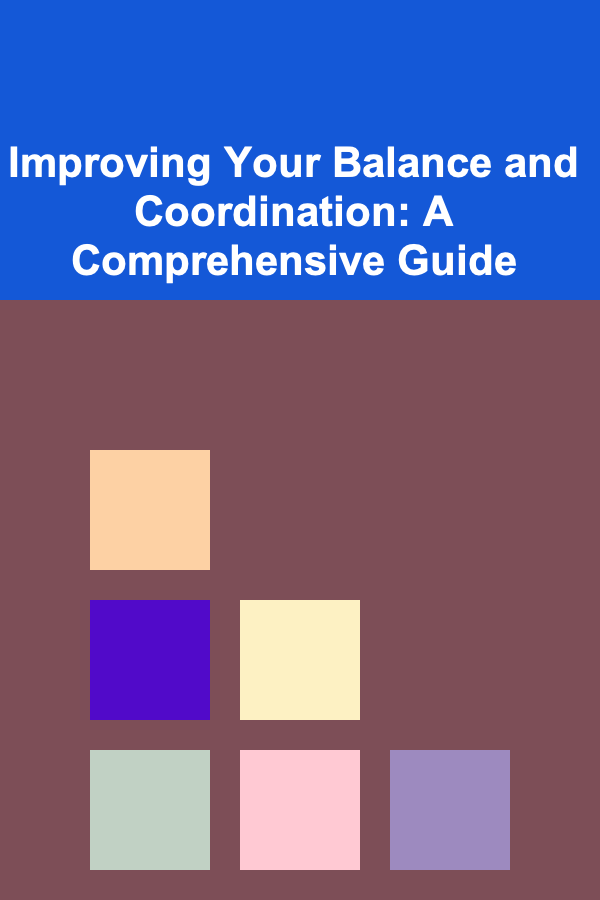
Improving Your Balance and Coordination: A Comprehensive Guide
ebook include PDF & Audio bundle (Micro Guide)
$12.99$9.99
Limited Time Offer! Order within the next:

Introduction: The Pillars of Stability and Grace
Balance and coordination are fundamental aspects of human movement, impacting everything from walking and running to complex athletic maneuvers and everyday activities. They are not innate gifts, but rather skills that can be cultivated and improved through targeted training and mindful practice. While often taken for granted when functioning optimally, deficits in balance and coordination can significantly impact quality of life, increasing the risk of falls, limiting mobility, and affecting overall confidence and independence.
This guide provides a comprehensive exploration of balance and coordination, delving into the underlying mechanisms, identifying factors that can affect them, and offering practical strategies and exercises to enhance these essential skills. Whether you're an athlete seeking to optimize performance, an older adult aiming to maintain independence, or simply someone looking to improve your overall well-being, understanding and actively working on your balance and coordination can yield significant benefits.
We will explore the intricate interplay of the sensory systems, the role of the brain in processing information and executing movement, and the importance of strength, flexibility, and proprioception in achieving optimal stability and graceful movement. By understanding these principles and implementing the exercises and strategies outlined below, you can take proactive steps to improve your balance and coordination and enjoy a more active, confident, and fulfilling life.
Understanding Balance and Coordination: A Deeper Dive
The Sensory Symphony: Systems Involved in Balance
Balance is not a single entity, but rather the result of a complex interplay between several sensory systems working in harmony. These systems constantly gather information about our body's position in space and relay it to the brain, which then orchestrates the appropriate muscular responses to maintain stability. The primary sensory systems involved in balance include:
- The Vestibular System: Located in the inner ear, the vestibular system detects changes in head position and movement. It contains fluid-filled canals and sensory receptors that respond to both linear and rotational acceleration. This information is crucial for maintaining balance during head movements and navigating uneven terrain.
- Vision: Our eyes provide visual cues about our surroundings, helping us to orient ourselves and maintain balance. Peripheral vision is particularly important for detecting potential obstacles and maintaining postural stability.
- Proprioception: This is our "sense of body awareness." Proprioceptors are sensory receptors located in muscles, tendons, and joints that provide information about body position, movement, and force. This information allows us to maintain balance without constantly looking at our limbs. For instance, proprioception allows us to walk without consciously thinking about each step.
- Somatosensation: This includes touch, pressure, and vibration sensations from our skin and underlying tissues. The pressure receptors in our feet provide information about our contact with the ground, helping us to maintain balance and adjust our posture accordingly.
The brain integrates information from all these sensory systems to create a comprehensive picture of our body's position in space. When one or more of these systems is impaired, it can lead to balance problems.
Coordination: The Art of Smooth Movement
Coordination refers to the ability to smoothly and efficiently execute movements involving multiple muscles or body parts. It relies on the brain's ability to plan, sequence, and control muscle activation patterns in a precise and timely manner. Coordination involves:
- Motor Planning: Developing a strategy for executing a movement.
- Sequencing: Arranging the steps of a movement in the correct order.
- Timing: Activating muscles at the appropriate time to produce a smooth and coordinated movement.
- Motor Control: Regulating the force and timing of muscle contractions to achieve the desired outcome.
Good coordination is essential for a wide range of activities, from simple tasks like buttoning a shirt to complex athletic movements. Impaired coordination can result in clumsiness, difficulty with fine motor skills, and an increased risk of falls.
The Brain's Role: The Central Command Center
The brain plays a crucial role in both balance and coordination. Several brain regions are involved in processing sensory information, planning movements, and controlling muscle activity. Key brain regions involved in balance and coordination include:
- Cerebellum: This region is responsible for coordinating movement, maintaining balance, and learning motor skills. It receives sensory information from the vestibular system, vision, and proprioceptors and uses this information to fine-tune movements and maintain postural stability.
- Brainstem: The brainstem contains several nuclei that are involved in controlling balance and posture. It receives input from the vestibular system and sends signals to the muscles that control head and body position.
- Cerebral Cortex: The cerebral cortex is responsible for planning and initiating movements. It receives input from the sensory systems and the cerebellum and uses this information to create motor plans.
Damage to any of these brain regions can lead to balance and coordination problems. Stroke, traumatic brain injury, and neurodegenerative diseases can all affect balance and coordination.
Factors Affecting Balance and Coordination
Numerous factors can influence an individual's balance and coordination. Understanding these factors is crucial for identifying potential risk factors and developing personalized strategies for improvement. These factors can be broadly categorized as:
Age-Related Changes
As we age, several physiological changes can impact balance and coordination. These include:
- Sensory Decline: Vision, hearing, and proprioception can all decline with age, making it more difficult to maintain balance.
- Muscle Weakness: Age-related muscle loss (sarcopenia) can weaken the muscles that support balance and coordination.
- Slower Reaction Times: Older adults may have slower reaction times, making it more difficult to respond quickly to changes in balance.
- Cognitive Decline: Cognitive impairment can affect attention, decision-making, and motor planning, all of which are important for balance and coordination.
Medical Conditions
Certain medical conditions can also affect balance and coordination, including:
- Vestibular Disorders: Conditions that affect the inner ear, such as vertigo and Meniere's disease, can cause dizziness and imbalance.
- Neurological Disorders: Conditions such as Parkinson's disease, multiple sclerosis, and stroke can affect the brain's ability to control movement and maintain balance.
- Musculoskeletal Problems: Arthritis, back pain, and other musculoskeletal problems can limit range of motion and weaken the muscles that support balance.
- Cardiovascular Disease: Conditions that affect blood flow to the brain can impair balance and coordination.
- Medications: Certain medications, such as sedatives, antidepressants, and anti-hypertensives, can cause dizziness and imbalance as side effects.
Lifestyle Factors
Lifestyle factors can also play a role in balance and coordination. These include:
- Physical Inactivity: A sedentary lifestyle can lead to muscle weakness and reduced flexibility, which can negatively impact balance and coordination.
- Poor Nutrition: Nutrient deficiencies can affect muscle strength and nerve function, which can impair balance and coordination.
- Dehydration: Dehydration can cause dizziness and fatigue, which can increase the risk of falls.
- Alcohol Consumption: Alcohol can impair balance and coordination.
- Vision Problems: Uncorrected vision problems can make it difficult to maintain balance.
Environmental Factors
The environment can also contribute to balance and coordination problems. Common environmental hazards include:
- Uneven Surfaces: Walking on uneven surfaces, such as grass or gravel, can challenge balance and increase the risk of falls.
- Poor Lighting: Dim lighting can make it difficult to see obstacles and maintain balance.
- Slippery Surfaces: Wet floors, ice, and snow can increase the risk of falls.
- Clutter: Cluttered environments can create tripping hazards.
Strategies for Improving Balance and Coordination
Fortunately, balance and coordination are skills that can be improved through targeted training and mindful practice. The following strategies can help you enhance your balance and coordination, regardless of your age or fitness level.
Balance Exercises
Balance exercises challenge your body's ability to maintain stability in different positions. Start with easier exercises and gradually progress to more challenging ones as your balance improves. Always perform these exercises in a safe environment, preferably near a wall or sturdy object that you can hold onto for support.
- Standing on One Leg: Stand on one leg for 30 seconds, then switch legs. You can hold onto a wall or chair for support if needed. As you improve, try closing your eyes or standing on a cushion to make the exercise more challenging.
- Heel-to-Toe Walking: Walk in a straight line, placing the heel of one foot directly in front of the toes of the other foot. Focus on maintaining a steady gaze and avoiding swaying.
- Weight Shifting: Stand with your feet shoulder-width apart and shift your weight from side to side and forward and backward. Focus on maintaining your balance and avoiding leaning too far in any direction.
- Tandem Stance: Stand with one foot directly in front of the other, heel touching toe. Hold for 30 seconds, then switch the position of your feet. Progress to closing your eyes for an added challenge.
- Bosu Ball Exercises: Use a Bosu ball (a half-dome stability trainer) to perform balance exercises. Standing, squatting, or performing other exercises on a Bosu ball can challenge your balance and improve stability.
- Tai Chi: Tai Chi is a gentle form of exercise that involves slow, flowing movements. It can improve balance, coordination, and flexibility. Studies have shown that Tai Chi reduces the risk of falls in older adults.
- Yoga: Yoga incorporates various poses that challenge balance and improve flexibility and strength. Holding poses like tree pose (Vrksasana) or warrior pose (Virabhadrasana) can significantly improve balance.
Coordination Exercises
Coordination exercises improve the ability to smoothly and efficiently execute movements involving multiple muscles or body parts. These exercises focus on improving the communication between the brain and the muscles.
- Juggling: Juggling is a great way to improve hand-eye coordination and timing. Start with two balls and gradually progress to three or more.
- Throwing and Catching: Throwing and catching a ball can improve hand-eye coordination and reaction time. Start with a large ball and gradually progress to a smaller ball. Try throwing the ball against a wall and catching it, or playing catch with a partner.
- Cross-Crawl Exercises: These exercises involve coordinating movements of opposite limbs. For example, touch your left elbow to your right knee, then repeat on the other side.
- Finger Tapping: Tap each finger to your thumb in sequence. Repeat the sequence several times, then try tapping with both hands simultaneously.
- Drawing Shapes with Your Feet: While seated, practice drawing different shapes (circles, squares, figure eights) in the air with each foot. This enhances coordination and ankle mobility.
- Dancing: Dancing involves coordinating a variety of movements and can be a fun and effective way to improve coordination.
- Playing Musical Instruments: Playing instruments like the piano or drums requires precise coordination between hands and feet, enhancing motor skills and cognitive function.
Strength Training
Strength training can improve balance and coordination by strengthening the muscles that support balance and movement. Focus on strengthening the muscles in your legs, core, and back.
- Squats: Squats strengthen the muscles in your legs and core.
- Lunges: Lunges strengthen the muscles in your legs and improve balance.
- Calf Raises: Calf raises strengthen the muscles in your calves, which are important for balance.
- Plank: The plank strengthens your core muscles, improving stability and balance.
- Back Extensions: These strengthen the muscles of your lower back, which are crucial for maintaining proper posture and balance.
- Glute Bridges: These strengthen your glutes and hamstrings, which contribute significantly to lower body stability.
Flexibility Training
Flexibility training can improve range of motion and reduce stiffness, which can improve balance and coordination. Focus on stretching the muscles in your legs, hips, and back.
- Hamstring Stretches: Stretching your hamstrings can improve flexibility in your legs and reduce the risk of falls.
- Hip Flexor Stretches: Stretching your hip flexors can improve range of motion and reduce stiffness in your hips.
- Back Stretches: Stretching your back can improve flexibility and reduce back pain.
- Calf Stretches: Stretching your calf muscles improves ankle flexibility, which is vital for balance.
- Shoulder Stretches: Increased shoulder flexibility can improve posture and upper body coordination.
- Yoga and Pilates: These practices inherently improve flexibility through a variety of stretching and strengthening exercises.
Proprioceptive Training
Proprioceptive training improves your body's awareness of its position in space. This can be achieved through exercises that challenge your balance and coordination.
- Standing on Uneven Surfaces: Standing on a balance board, wobble board, or foam pad can challenge your proprioception and improve balance.
- Eyes Closed Exercises: Performing balance exercises with your eyes closed can challenge your proprioception and improve balance.
- Reaching Exercises: Reach for objects in different directions while maintaining your balance. This can improve your body's awareness of its position in space.
- Agility Ladder Drills: These drills improve footwork, coordination, and proprioception by requiring quick and precise movements.
- Jump Rope: Jumping rope improves coordination, timing, and proprioceptive awareness in the lower body.
Practical Tips for Daily Life
In addition to targeted exercises, incorporating simple strategies into your daily life can significantly improve your balance and coordination.
- Maintain a Healthy Weight: Excess weight can put extra strain on your joints and muscles, which can affect balance and coordination.
- Eat a Balanced Diet: A healthy diet provides the nutrients your body needs to maintain muscle strength and nerve function.
- Stay Hydrated: Dehydration can cause dizziness and fatigue, which can increase the risk of falls.
- Get Regular Exercise: Regular exercise can improve muscle strength, flexibility, and coordination.
- Wear Supportive Shoes: Shoes with good support and traction can help you maintain balance. Avoid wearing high heels or loose-fitting shoes.
- Use Assistive Devices: If you have difficulty with balance, consider using a cane or walker to provide extra support.
- Improve Your Home Safety: Make your home safer by removing tripping hazards, installing grab bars in the bathroom, and improving lighting.
- Be Mindful of Your Posture: Good posture can help improve balance and reduce the risk of falls. Stand tall with your shoulders back and your head level.
- Pay Attention to Your Surroundings: Be aware of your surroundings and watch out for potential hazards, such as uneven surfaces, slippery floors, and clutter.
- Get Regular Vision Checks: Vision problems can affect balance. Have your vision checked regularly and wear corrective lenses if needed.
- Be Aware of Medications: Be aware of the side effects of any medications you are taking, as some can cause dizziness or imbalance. Discuss any concerns with your doctor.
When to Seek Professional Help
While many balance and coordination problems can be addressed through self-management strategies, it's important to seek professional help if you experience any of the following:
- Frequent Falls: Falling more than once in a short period of time is a sign that you may have a balance problem.
- Dizziness or Vertigo: If you experience frequent dizziness or vertigo, see a doctor to determine the underlying cause.
- Difficulty Walking or Standing: If you have difficulty walking or standing, see a doctor or physical therapist to assess your balance and coordination.
- Clumsiness or Difficulty with Fine Motor Skills: If you experience clumsiness or difficulty with fine motor skills, see a doctor to rule out any underlying neurological conditions.
- Sudden Onset of Balance Problems: A sudden onset of balance problems can be a sign of a serious medical condition, such as a stroke. Seek immediate medical attention.
A doctor or physical therapist can evaluate your balance and coordination, identify any underlying causes, and develop a personalized treatment plan to help you improve your balance and reduce your risk of falls. They may recommend specific exercises, assistive devices, or other interventions based on your individual needs.
Conclusion: Embracing Stability and Grace
Improving your balance and coordination is an ongoing process that requires dedication, patience, and a proactive approach. By understanding the underlying mechanisms, addressing contributing factors, and consistently implementing the strategies outlined in this guide, you can significantly enhance your stability, improve your movement efficiency, and reduce your risk of falls.
Remember that progress may be gradual, and it's essential to be patient with yourself and celebrate small victories along the way. Listen to your body, avoid pushing yourself too hard, and adjust the exercises and strategies to fit your individual needs and abilities. Embrace the journey towards improved balance and coordination, and enjoy the benefits of a more active, confident, and fulfilling life.
By prioritizing balance and coordination, you are investing in your long-term health, independence, and overall well-being. So, take the first step today, and start building a foundation of stability and grace for years to come.

How to Start Investing in Agricultural Commodities
Read More
How to Use Coupons and Discounts to Save Money at Home
Read More
How to Utilize Vertical Space for Storing Pet Items
Read More
Operations Research Analyst: Strategies for Optimal Decision Making
Read More
How to Explore Blockchain for Intellectual Property
Read More
How to Prepare for a Dance Audition: A Complete Checklist
Read MoreOther Products

How to Start Investing in Agricultural Commodities
Read More
How to Use Coupons and Discounts to Save Money at Home
Read More
How to Utilize Vertical Space for Storing Pet Items
Read More
Operations Research Analyst: Strategies for Optimal Decision Making
Read More
How to Explore Blockchain for Intellectual Property
Read More